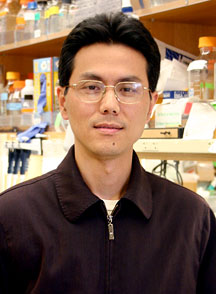

High Resolution "Snapshots" Detail Dynamics of a Cocaine Antibody
By Eric Sauter
Scientists at The Scripps Research Institute have revealed for the first time a series of molecular structures of a specific cocaine-degrading monoclonal antibody Fab' fragment during the complete catalytic process—a chain of events that breaks the drug into nontoxic pieces. Understanding these significant structural changes of the antibody 7A1 could help in the development of a treatment for cocaine addiction. A monoclonal antibody is cloned from a single type of immune cell.
Cocaine-binding antibodies have shown some promise in their ability to neutralize cocaine toxicity, but their binding ability is severely impaired by high concentrations of the drug. A catalytic monoclonal antibody such as 7A1, on the other hand, has the ability to regenerate after each new dose of the drug, making it far more effective than others in metabolizing cocaine.
The study, which will be published in the February issue (Volume 14 Issue 2) of the journal Structure, was led by Ian A. Wilson of Scripps Research Department of Molecular Biology and The Skaggs Institute for Chemical Biology, and Kim D. Janda of Scripps Research Departments of Chemistry and Immunology and The Skaggs Institute for Chemical Biology.
Despite intensive research, cocaine abuse continues to be a major public health problem, so far eluding efforts at developing an effective therapeutic agent to counter the craving, addiction, and overdose of the drug. To date, no treatment has been approved by the Food and Drug Administration (FDA).
Commenting on the new findings, Xueyong Zhu, the primary author of the study and a staff scientist in the Wilson laboratory said, "Development of effective therapies for cocaine abuse has been a long-standing goal, and a number of medications under study do show some promise. Immunopharmacotherapy has been proposed as a way to neutralize the drug outside the central nervous system—basically soaking up the drug before it has a chance to cross the blood brain barrier—as a potentially effective new approach to treat cocaine abuse."
Using a monoclonal antibody endowed not only with high binding ability, but also with sufficient catalytic activity to metabolize cocaine, would have potentially enhanced therapeutic effects, Zhu said. This antibody could intercept cocaine in the blood stream before it reaches the central nervous system—stopping the drug cold. Because cocaine has a half life of approximately 30 minutes inside the human body, a cocaine catalytic antibody would basically have to out-run the body's natural metabolism process to have any serious impact on the psychoactive effects of the drug.
Generated by x-ray crystallography, pictures of the conformational changes that occur during the antibody's complete catalytic cycle show the molecular basis for catalysis and reveal possible mutations that could increase catalytic proficiency. This, Zhu pointed out, provides a foundation for the humanization and mutagenesis of the antibody to enhance its cocaine-hydrolyzing activity and make future human clinical trials feasible. "Given the fact that catalytic antibodies have been produced with the same levels of efficiency as natural enzymes, it seems well within the realm of possibility," he added.
To reach this ambitious goal, however, it may be necessary to explore new incremental approaches for optimizing the efficiency of such catalytic activity. Novel functional groups could be introduced into first generation antibody catalysts by multiple rounds of mutagenesis and selection to produce improvements. In essence, this would allow scientists to dramatically accelerate the evolutionary process, producing improvements in the immune system in weeks or months that previously took billions of years.
"The structural insights into antibody catalysis that we have shown with 7A1 Fab' are critical for any future improvement of effective biocatalysts," Zhu said. "One of the main goals of our lab has been to focus on catalytic antibodies that will have a direct impact on public health issues. With the snapshots of the complete cycle of the cocaine antibody catalytic reaction, we have shed new light on the sequence of events in an antibody-mediated reaction and provided a rare glimpse of the structural dynamics involved. With this information, it's possible to move onto the next step in the development of a treatment for cocaine abuse and addiction."
Other authors of the study include Tobin J. Dickerson, Claude J. Rogers, Gunnar F. Kaufmann, Jenny M. Mee, and Kathleen M. McKenzie.
Support for the study was provided by grants from the National Institutes of Health, The Skaggs Institute for Chemical Biology and Scripps Research.
Send comments to: mikaono[at]scripps.edu

"With this information, it's possible to move onto the next step in the development of a treatment for cocaine abuse and addiction," says Staff Scientist Xueyong Zhu, first author of the recent study. Photo by Kevin Fung.
